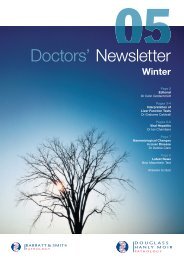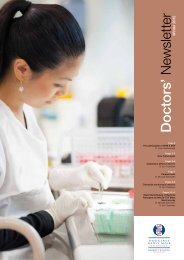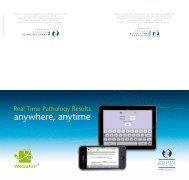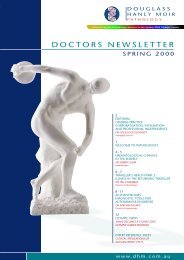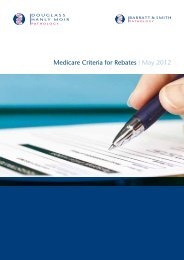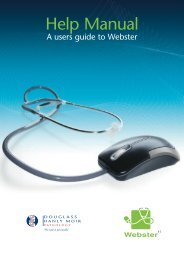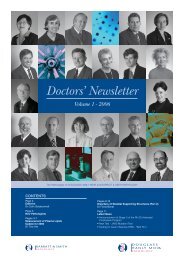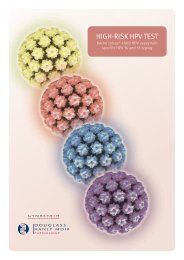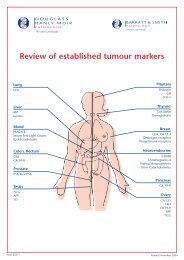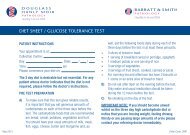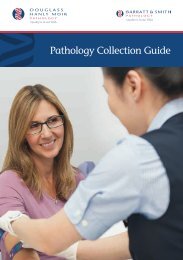EditorialLaboratory QualityThe Heart of our PracticeDr Colin GoldschmidtChief Executive OfficerWelcome to the Spring 2005 Doctors’ Newsletter! In thisedition we offer review articles on INR management, HIVtesting, and the first of a two-part article on tendinopathies.INR and HIV tests both exemplify how crucial it is fora laboratory to achieve excellence and consistency indiagnostic testing. Both have in common potentiallyprofound implications for the patient, should the result beunreliable. Although these two tests are particularly goodillustrations, all laboratory results, of course, have importantimplications for patient management.Those who work in laboratories know how muchbehind-the-scenes effort is required of them to produceresults of a consistently high standard. Quality Control maynot be one of the most obvious features of the serviceyou receive but it is certainly one of our most importantactivities.At <strong>Douglass</strong> <strong>Hanly</strong> <strong>Moir</strong> <strong>Pathology</strong>, and at Barratt and Smith<strong>Pathology</strong>, we have always placed quality at the very heartof our existence as pathology practices.To take the INR as an example, in order to generatethe thousands of reliable INR results per year which weproduce, we must test a variety of control specimens manytimes during the working day, and then act immediatelyon any discrepancies. Results which are at variance froma patient’s previous result are repeated as a matter ofcourse, and if particularly unexpected or abnormal, may beassessed by a manual method as well as an automatedone. Abnormal results are always overseen by a seniorscientist or pathologist. In addition, the laboratories withinour organisation take part in regular inter-laboratory qualitycontrol exercises.Every investigation performed by our laboratory has its ownQuality Control scheme, tailored to the individual test toachieve the best result, and this includes our histopathologyreports. Regular external assessment of performance andparticipation in continuing education by all our pathologistsis vital to this activity.Performance in external Quality Control exercises is, ofcourse, one of the best objective measurements of quality.For more than 30 years, the Royal College of Pathologistsof Australasia has led the provision of well-organisednational proficiency testing. We are enthusiastic participantsin their schemes, and take pride in our success. NATAaccreditation adds a further layer to the external supervisionof quality of results.Of course, the final quality assessment lies with you, our“customers”, to whom we owe a great debt for discussingour service with us and for bringing to our attention anyapparent anomalies. We welcome every opportunity to dothis and are more than happy to repeat any investigationat your request if you feel the result does not appear to ‘fit’with your clinical assessment.Space does not permit me to expand further on our manyquality activities, however all of our pathologists, includingmyself, are happy to discuss any queries you may haveabout this aspect of our service.Meanwhile it remains for me to thank you very much foryour ongoing support.With my best wishes,Dr Colin GoldschmidtM.B.B.Ch., F.R.C.P.A., F.A.I.C.D.Chief Executive Officer<strong>Douglass</strong> <strong>Hanly</strong> <strong>Moir</strong> <strong>Pathology</strong>Barratt & Smith <strong>Pathology</strong>2
Warfarin ManagementWarfarin is one of the most commonly prescribed drugs.It is used as prophylaxis against thrombosis in the venousand arterial vasculature. It is effective in reducing the riskof thrombosis but has a narrow therapeutic window. Thereare only a few alternative drugs especially for long-termprophylaxis against thrombosis. Therefore the decision toanticoagulate a patient with warfarin is a decision to choosethe lesser of two evils.The therapeutic effect of warfarin is assessed with the INR(international normalised ratio for the prothrombin time). Theeffectiveness of warfarin has been shown in clinical trialsto be related to the INR, both the absolute level and thestability. Similarly, the side effects of warfarin therapy maybe related to high INR and variability of the INR.The rest of the article will concentrate on matters that mayinfluence the variability of the INR. The following are someof my thoughts about warfarin management that maybe helpful.Patient FactorsDoseDr Jonathan BlackwellHaematologistA forgotten a dose of warfarin is not infrequent. The patientshould not take extra, but be encouraged to be diligent withwarfarin doses. Testing too soon after the missed dosee.g. within three days, is likely to be misleading.I am sometimes asked why some patients require muchlarger doses of warfarin than others, i.e. seem to be“resistant” to warfarin. Genetic factors leading to differentmetabolism are increasingly recognised as a cause of widevariation in warfarin doses between patients. This type ofprofiling is still only used in clinical research.DietHigh dietary Vitamin K intake will reduce the INR. Greenleafy vegetables such as spinach, cabbage or cauliflowerare well known. Some cheeses, nuts and liver products areother foods high in vitamin K.Variation in the intake of Vitamin K rich foods from day today may lead to increased INR variability.Warfarin is well absorbed from the gut. Small bowel diseaseor poor oral intake will reduce the Vitamin K absorption andtherefore increase the INR.Malnutrition or intercurrent illness will affect warfarin proteinbinding and may increase the INR.AlcoholAlcohol consumption that is high and chronic may increasethe clearance of warfarin and therefore decrease the INR. Apatient with liver dysfunction will, however, have decreasedsynthesis of coagulation factors and therefore may haveincreased sensitivity to warfarin. Small regular amounts ofalcohol do not have a great influence on the INR.Understating alcohol consumption, particularly “bingeing”, isa common cause of variable INR.MedicationsMany drugs may potentiate warfarin and therefore increasethe INR.Some Drugs increasing the INRCotrimoxazoleErythromycinMetronidazoleIsoniazidAmiodaroneClofibrateOmeprazolePhenylbutazoneSome Drugs decreasing the INRCholestyramineRifampicinCarbamazepineSucralfateBarbiturates3



